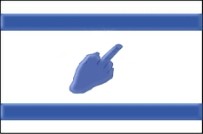This is what happens when an active Elder leaves the post unattended for a few days. One scribe gets onto a juicy tidbit, and here we are - almost on the brink of war with Sweden. Of course, we could take them easily, but who needs that piece of mostly frozen real estate (it is not for nothing that Swedes themselves were warring with their neighbors for hundreds of years: they were trying to break out of the place, is all)? And the associated fuel and traveling expenses? Nah, this is really a non-starter.
So, in order to allow everyone to chill out, the Elders decided to let the Troof be known and to settle the issue once and for all. Here come some relevant excerpts from the IDF field manual on organ harvesting. Due to shortage of time, the need for translation (the manual is written in Aramaic to encumber its dissemination) and overabundance of irrelevant technical details, only a part of the manual, sufficient for full disclosure, is published - as usual here, for the first time!
(In the name of Ba'al, Beelzebub and the Elders - by IDF medical corps)
1. Introduction
Organ Harvesting (OH) is one of the objectives to be reached by any field unit alongside its usual field duties, such as (but not limited to) mayhem, destruction, killing, maiming an raping the population and/or livestock, in short - Occupational Therapy (OT).
Every unit is given its OH quota for the day as part of its OT assignment. OH quota is a minimal requirement and could and should be complemented by a) random harvesting of valuable organs from especially healthy Donors (D) and b) harvesting for personal needs, when such harvesting is not contradictory to the requirements of the OH quota. IDF does not object to such fulfillment of personal needs (or desires), as long as such fulfillment improves the morale of the troops.
... [follows a long ideological treatise dealing with the justification of OH based on superiority of Jooz as chosen people, obvious stuff omitted for brevity]
2. Technical advisory
Generally, the preference is for the D to be delivered to the medical staff from the field alive and undamaged, so the harvesting could be performed in the optimal conditions of the professional surgery. However, when the potential D resists plucking, especially when using weapons, it is permissible to immobilize D or even kill him/her if the need arises (the latter act is allowed only if the field unit is equipped by mobile cold storage vehicle.
2.1 Immobilizing D
When D is not responsive to verbal invitation to follow the unit to the nearby medical facility for OH and shows the first signs of rejecting the said invitation, a sharp knock on D's head with a blunt object will usually suffice to overcome the resistance. Plastic handcuffs will then be applied to prevent further inconvenience.
If D is running away and there is no possibility of catching him/her, use of the firearms is indicated. Such use, however, must be judicious and in no way should damage the important organs, which will defeat the whole purpose of OH. To prevent such damage, a diagram of the potential D is shown* below:
 The areas painted green are the ones where the D could be shot. Soldiers who damage any other part of D should be punished. After apprehension, D should be given all necessary first aid and care to be transported to the surgery alive.
The areas painted green are the ones where the D could be shot. Soldiers who damage any other part of D should be punished. After apprehension, D should be given all necessary first aid and care to be transported to the surgery alive.2.2 Killing D
The only area where D could be shot for the purpose is shown on the diagram below:
 After the shot, the body should be immediately placed in the cold storage and transported with all due dispatch to the medical facility.
After the shot, the body should be immediately placed in the cold storage and transported with all due dispatch to the medical facility.2.3 Disposal of badly damaged cadavers
If a misplaced round damaged the D's body beyond possible usability, the said body could be transferred to the relatives of the D, after consultation with the unit cook. In case of severe shortage of food supplies - see the Field Manual on Creative Cooking.
... [the standard army morning prayer thanking the deity for giving us spare parts of the gentiles is omitted for brevity here]
(*) Being underfunded as a matter of tradition, the Medical Corps were unable to acquire a clear representation of a human body. This substitute, reaped from an Internet site, is all that was available.


0 comments:
Post a Comment